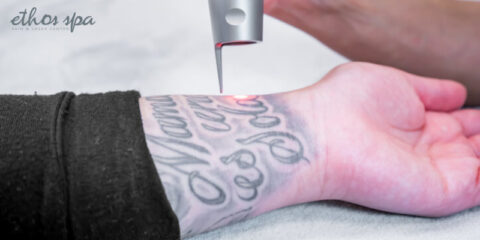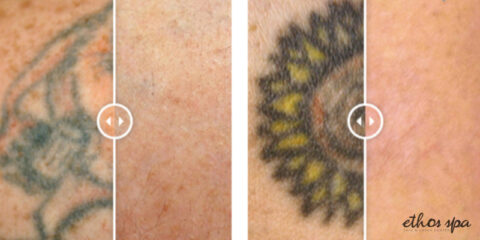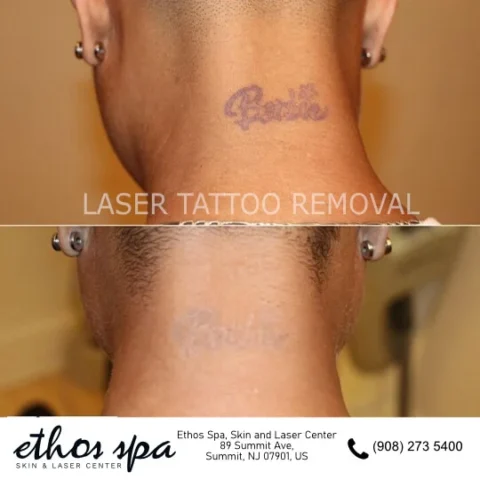Tattoos have always been a popular form of self-expression, but recent developments have elevated tattoos into a new level of body art. White ink tattoos grew as a trend in the early 2010s, thanks to their subtle, lace-like look. However, having white ink tattoos removed is a completely different story.
So is white ink tattoo removal even possible? Board-certified plastic surgeons and medical aestheticians agree that white ink tattoo removal can be done but it will be very difficult.
Based on what has been observed so far, white ink laser tattoo removal takes more sessions and leads to less predictable results.
Is White Ink Tattoo Removal Possible?
White ink tattoos are unique because it doesn’t follow the normal process of stenciling the treatment area and outlining the tattoo in black. The tattoo itself is completely done with a thick, white ink which requires several passes through the area to sink the ink into the skin.
Ordinarily, laser tattoo removal works by targeting certain colors of ink with a type of light it can absorb. Black ink is the easiest color to remove because it absorbs all kinds of light. Once the light is absorbed by the ink, it breaks up the ink particles so your body can remove them safely.
The problem with white ink is that white reflects all kinds of light. It won’t absorb light the same way other ink colors do. In fact, soft colors like pink, yellow, or orange can already be a challenge because of how little they absorb the laser light. Colors mixed with white may also be complicated to treat.
For example, a light blue (made up of dark blue and white ink) cannot easily be treated with a laser either, as the white “shields” the dark blue pigment. It would take more sessions to remove a white ink tattoo because your technician has to darken, then lighten the tattoo before it is completely removed.
Aside from light absorption, there is also a chance that white ink becomes darker permanently during the laser removal procedure. As white ink often contains zinc or titanium oxide, it darkens with exposure to light. You may end up with a black or gray tattoo that is impossible to remove.
In summary, white body art is definitely a “think before you ink” situation. As cool as white tattoos are, they are definitely not easy to get rid of if you want to remove them in the future. White tattoos are not as easy to predict as green, dark blue, or black tattoos either. It’s best to find more information on white tattoos to prevent yourself from making a mistake.
Other Factors To Consider in White Tattoo Removal
Aside from the technical difficulty you may encounter with white tattoo removal, there are other factors which could influence removal treatment as well:
Placement
White tattoos are not ideal in certain areas of the body, as they are exposed to the sun, the weather, harsh household chemicals, and other elements. When the tattoo becomes damaged and fades, it can be especially tricky to remove it completely.
Size of Tattoo
Unsurprisingly, bigger tattoos are much harder to remove than smaller tattoos. A white tattoo that is 12 inches in diameter (or larger) may require more than 10 laser treatments. With smaller tattoos, there is a lot less ink so it’s easier for the laser to break down.
Color of Tattoo
White is a translucent pigment, rather than opaque. If an open wound with white ink comes into contact with green or another color, it can become stained and difficult to remove. In order to treat white body art, some tattoo artists work around the white ink after performing a test spot first, in case the ink will present a negative reaction.
Age of Tattoo
Older, more faded tattoos are much easier to remove than newer ones. A newly-inked, black tattoo can take up to 15 laser sessions to remove, which can be more expensive. On the other hand, older markings only require 4 – 6 sessions. How does this happen?
Older tattoos have been exposed to the sun over the years. As the sun is kind of like a laser, it can tear through the ink slowly as time goes by. Of course, staying out in the sun for a long time won’t do anything for a brand new tattoo. The human body also has a natural way of separating tattoo ink from the skin, but it requires help from laser heat to break ink down into nano-particles. Bearing with your unwanted white tattoo for a few years might make the removal process easier for you.
Skin Reactions
White ink can be more reactive for your skin compared to other colors. White ink formulas include a chemical compound called titanium dioxide, which are mixed with other chemicals such as lead carbonate, rutile, and anatase. Titanium dioxide and its variations are categorized as possible carcinogens, so the ingredients in white ink may be lethal to the tissues and cells around the treatment area.
As titanium dioxide mixed with those chemicals have not been fully tested on humans yet, there is not enough research to prove safe use. Aside from risks of toxicity, your skin may exhibit reactions like oozing, swelling, or itching from the tattoos — indicating your body is rejecting the white ink.
Ethos Spa: NJ’s Tattoo Removal Experts
Itching to have an unwanted tattoo removed? You’ll be in good hands at Ethos Spa. With our board certified surgeon and expert staff, we can help you get rid of your tattoos with minimal issues. After thousands of patients, you can be sure our team won’t make any major mistakes with your skin. For more information, schedule a consultation with us today.
Learn more: Laser Tattoo Removal Scars: Does It Work?







